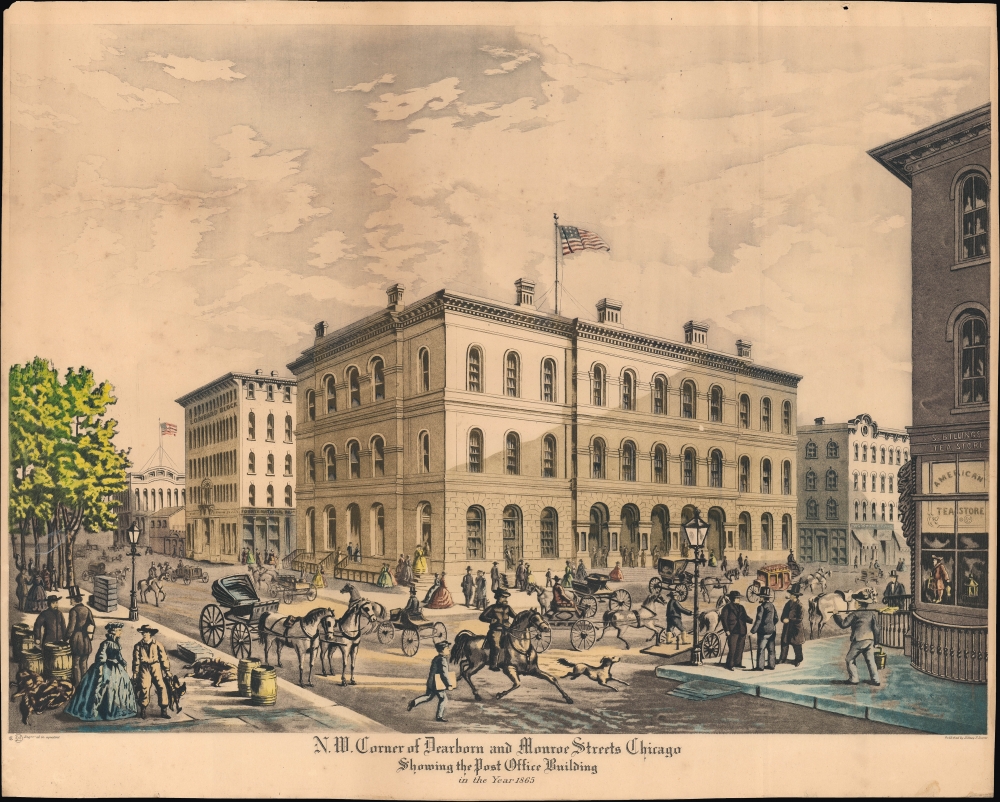1930 Varin View of the Post Office Building, Chicago, Illinois
ChicagoOldPostOffice1865-varin-1927
Title
1927 (undated) 17.25 x 21.5 in (43.815 x 54.61 cm)
Description
A Closer Look
As the title indicates, this view is oriented towards the northwest corner of Dearborn and Monroe Streets in Downtown Chicago, focusing on the large and impressive Post Office and Customs House that opened in 1855. The buildings on either side of the Post Office belonged to Benjamin F. Lombard, a very successful lawyer and banker, and were designed to match the Post Office Building in style and ambition. A tea shop at right and additional buildings at left are also depicted. The bustling street scene includes pedestrians, animals, horseback riders, and a variety of carts and carriages.The Chicago Post Office and Customs House
Erected in 1855, the Chicago Post Office and Customs House was a grand statement of the city's growing importance and future aspirations. The first floor consisted of the public-facing Post Office, while the second and third floor contained offices for the Postal Service and Customs Service. The building's Neoclassical style incorporated marble on both the exterior and interior and other fine furnishings, including drainage and sewage pipes. Employing a staff of more than one hundred, it was thought to immediately rank among the top post offices in the country in terms of importance. Unfortunately, the building was one of the many casualties of the Great Chicago Fire in October 1871.Aquatint
Aquatint is a printmaking technique that has been used since the 18th century. In aquatint, the artist creates an image by marking the surface of a copper or zinc plate. The marks hold the ink, which is then transferred to paper when the plate is passed through a printing press. One of the innovations of the aquatint process was the ability to create tonal variation depending on how the image was etched onto the printing plate.Publication History and Census
This view was created by Raoul Varin and published by Sidney Lucas in Chicago in 1927. Varin produced a series of thirty-one views of Chicago between 1926 and 1932, which focused on the appearance of historical buildings and other structures, including the many destroyed in the 1871 fire. Each of Varin's views was issued in a limited edition of 125 prints, many of which have suffered from poor framing and are generally not in the best condition. Lucas attained the rights to this print from A. Ackermann and Son, publishers of most of Varin's other prints. The Art Institute of Chicago is the only institution known to hold an example of this print.Cartographer
Raoul Varin (1865 - 1943) was a French watercolorist active in Europe and the North America in the late 19th and early 20th centuries. Varin exhibited in the Salon of French Artists and received an honorable mention in 1892. He is most famous for his historic Chicago aquatint views, of which he produced some 31 between 1926 and 1932. The collection included historic views drawn from early sources as current views of Chicago as Raoul saw it. Some were engraved by Ernest Byfield, who was the initial publisher of the series. Later, after Byfield went bankrupt, publication was taken over by A. Ackermann and Son's Chicago office. Buoyed by the success of his Chicago series, Varin went on to produce a series of 'Old New York', images, but these did not attain the same level of popularity. More by this mapmaker...

